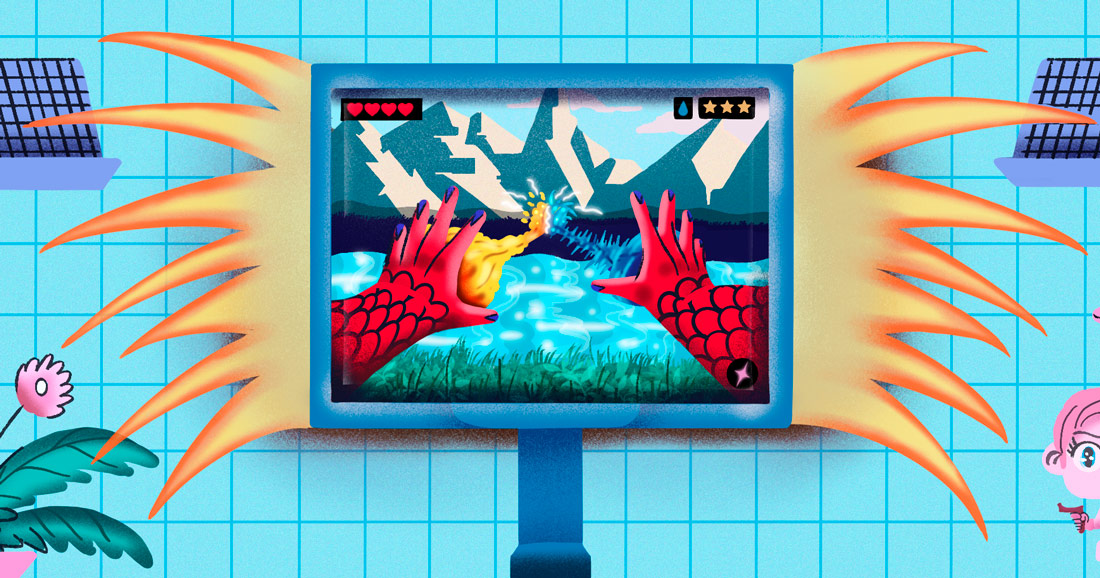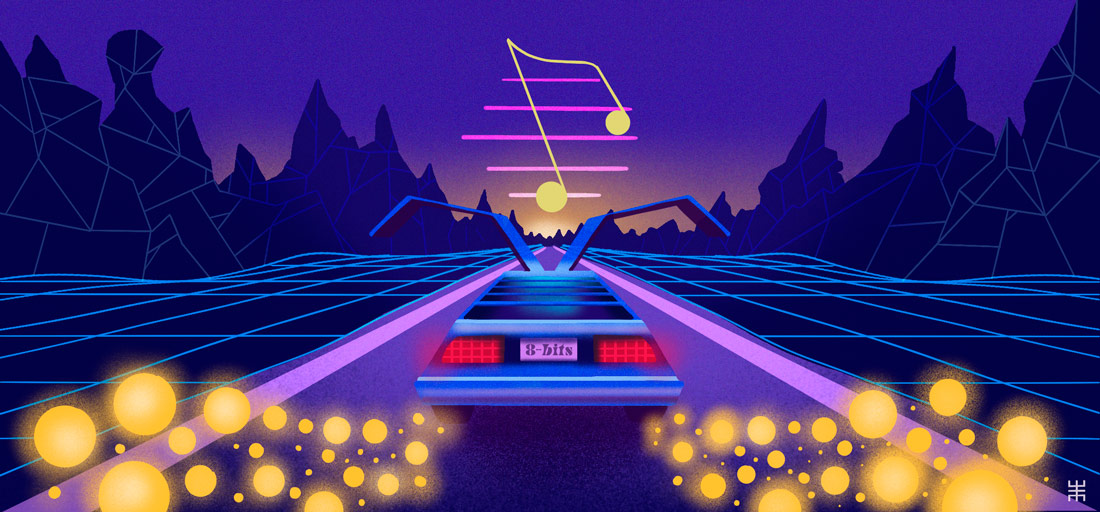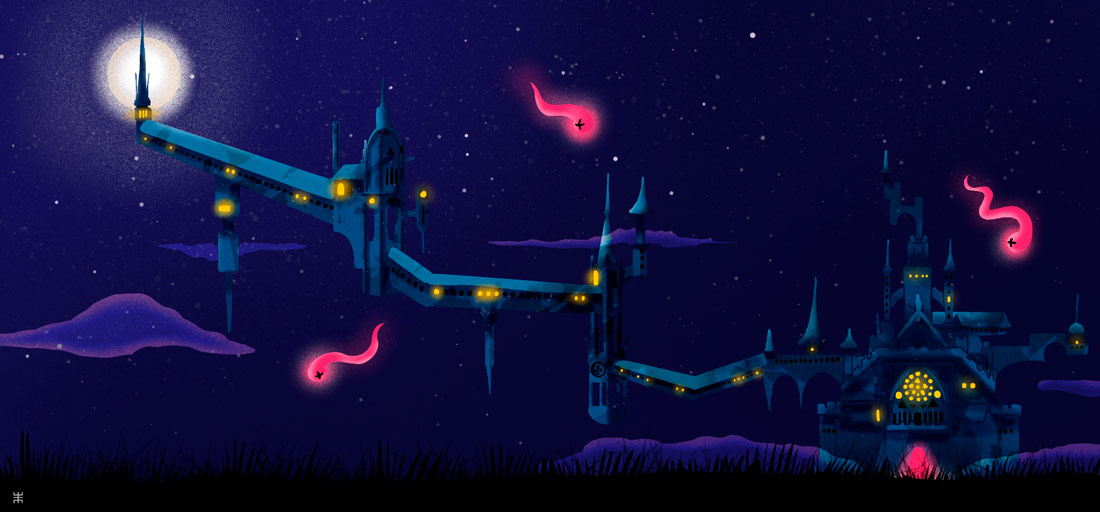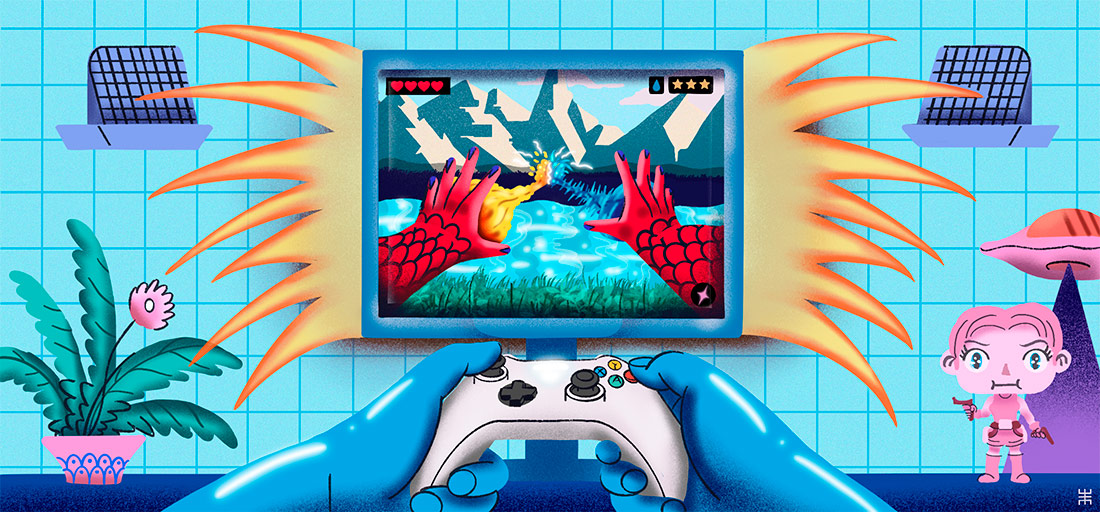
CC BY-NC Deiff Mg
We approach video games from disciplines apparently alien to them such as anthropology, pop culture, literature, and dance. Through these views we will discover the similarities between the history of video games and the life stages of a person, the power of the 1980s pop imaginary to awaken our nostalgia, what points are shared in common by gothic literature and video games, and the relationship between the body and the screen when playing.
- The Age of Video Games, by Adrià Pujol Cruells
- Chun-Li’s madeleine, by Marta Salicrú
- The coherence of conventions: on the gothic tradition and video games, by Lucía Lijtmaer
- The synthesised body. The heretical double, by María García Vera
The Age of Video Games
Adrià Pujol Cruells

CC BY-NC Deiff Mg
After over half a century of history, video-game culture and cultivation have passed through phases that remind one of the stages of a person’s growth. Broadly speaking, of course, because this conceptual approach can only be recreational.
Initially we find a primary playability, comparable to throwing a ball against the wall, followed by a child phased and a teenage phase, of exploration and testing of own expressive limits. We are currently at a stage of consolidated maturity: a more reflexive, even evocative era, in the sense of a conscious sedimentation on who one is – or has decided to be – on the journey made and the place occupied by video games in society, art, science, politics, the economy, dreams and language.
Examining the comparison more closely, in the 1950s video games were at a uterine, prenatal stage, that of the formation of the machine, in other words of the body: isolated, disconnected experiences, similar to those of a baby in its mother’s womb. Moving into the 1960s, we could talk of early infancy: in the case of humans this would run from 0 to 6 years, and in the case of video games it is the time of the first taking of awareness and realisation of their potential. In the 1970s they move into intermediate childhood (from 6 to 11 years in people), in other words the phase of the first really complex operations, the first total video games. The 1980s would coincide with adolescence (11-17 years), a fundamental phase for exploring one’s identity, and the 1990s would coincide with young adulthood (18-35 years), the phase of explosion of the identity. Finally, the 2000s and to date, would be equivalent to maturity (35-60 years), a phase that we are just savouring, of consolidation of identity and therefore of opening the doors to their fragmentation, memory, labelling and manipulation.
The stage of old age (65-? years) of the video game has not yet arrived.
Chun-Li’s madeleine
Marta Salicrú

CC BY-NC Deiff Mg
Pedalling through traffic-less streets lined along both sides with single-family homes, the wheels of the BMX can go no faster, then dropping it without so much as a padlock in front of the games arcade and polishing off that week’s pocket money playing – without much skill and without immortalizing any ephemeral match by leaving any initials – Pang. No, this is not an episode from Stranger Things, nor from the Stephen King fictions that inspired it; it is a scene from my childhood in the 1990s, which I am taken to by the chiptune cacophony of games arcades. Being born in the 1980s meant doing all this while singing Madonna, Michael Jackson and Mecano. But also singing by whistling without words the flat melodies emitted by extremely cheap chips from inside the consoles. Sing with me if you know them: Megaman by NES, as well as Tetris by GameBoy, Super Mario World by Super Nintendo – anyone who has not danced samba when the star leaves the block, is either deaf or is dead – the are “hits”, each and every one of them.
Is it contradictory that an industry with such a futuristic vocation as the world of video games, supported by state-of-the-art technologies, has this nostalgic potential – with the replicas in miniature in 2016 of the classic Nintendo consoles as the unsurpassable milestone of the “Retromania” that Simon Reynolds had denounced five years previously? Where does this power of evoking the past come from? Is it related to connection with the paradise lost of childhood? Or are these addictive tunes responsible for the journey in time in a musical 8-bit DeLorean? To put it another way: is the main theme tune of Super Mario Bros. our madeleine of Proust? The generation who learned to write by hand while moving around platforms with a little cross, those of us who reached our coming of age when the Internet did so in our homes and which virtualised our social life, back in the 1980s were eating industrial madeleines, And the resort of nostalgia is activated by the laughing of Chun-Li when she was winning in Street Fighter II: “Yatta!”.
The coherence of conventions: on the gothic tradition and video games
Lucía Lijtmaer

CC BY-NC Deiff Mg
Writer Grant Allen complained, towards the end of the nineteenth century, of a new evil that was devastating England: nervous exhaustion. It was not an unusual complaint: neurologists began to warn of a growing surge in nervous breakdowns due to the overstimulation caused by the new urban conurbations.
Let us leave the present for the moment and think about the change that the industrial revolution brought. The overload of information included morning and evening edition newspapers, two postal deliveries daily, telegrams that could arrive at any moment at any time of the day, not to mention the telephone and the new methods of transport that prevented you from taking in the whole landscape thanks to their fast new speeds. And in the cities? Theatre plays, music, bars, more newspapers, more magazines, and a long list of others that were the subjects of complaints from writers like Grant Allen – afflicted, like many other citizens, by nervous exhaustion.
It is Allen who is usually quoted to demonstrate how technology, paradoxically, gave rise to new forms of writing. Faced with the new printing culture which required constant content, Allen and many others began to write literature in a short format – better paid, of course, than news reports in newspapers. Generally, their output consisted of gothic tales of ghosts and horror stories.
The gothic literary tradition has more in common with video games than it appears to – although they also resemble each other in what we can take to be as their surface. The origin of video games is a history in which technological evolution is entwined with certain social changes and, simultaneously, the creation of new imaginaries. What we understand gothic to be – an aesthetic genre that can be summed up, according to specialist Chris Baldick, as a mix of terror and decadence that has been present since the end of the eighteenth century – shares with the origin of video games the tension between optimistic outlooks and fear in the face of a new technological era. This is why it is interesting to establish crossovers that may arise in the wake of the “Gameplay” exhibition.
In both there is a poetic of clear rules: ideas are transmitted and dynamics typical of a genre are promoted. From the start of gothic literature, which we can pinpoint with The Castle of Otranto, by Horace Walpole, and the first video games, there has been a quest to delve deep into the freedom of the imagination and the symbolic possibilities of a more or less fantastic scenario.
On the other hand, the representation of imaginary worlds that it seeks to imbue with unique experiences is enormously in tune with what is, perhaps, the most important feature of the gothic tradition: the atmosphere, something indefinable but representable even to the point of parody in the folklore tradition in which the gothic tradition is rooted – and also in a significant part of the experience in video games. Castles and labyrinths are essential in the gothic form, and thanks to Edgar Allen Poe they come to form part of its psyche – we are reminded of “The Fall of the House of Usher” which represents a fundamental transformation of the genre. Architecture is indispensable for gothic literature and it is the very structural essence of video games: we could say that they share labyrinths. If in one it is a way of enjoying through fear and decadence, in the other it is through the pleasure of deciding.
Of course, the spaces are crucial in both: “The Adventure of the Speckled Band” or The Hound of the Baskervilles by Arthur Conan Doyle, for example, are reflected in What Remains of Edith Finch, which is featured in the exhibition. In fact, their definitions could be interchangeable. In both there is an ancestral mansion that remains linked to a domestic tyranny that we must discover. Even Other Places, the work by Andy Kelly which is shown at “Gameplay”, pays tribute to the open worlds of video games, worlds that can be explored by the player and are transformed into uninhabited worlds, where the action is suspended and where the fictional landscape acquires all of the protagonism. This is exactly the same as the Victorian drift in the gothic novels of the Brontë sisters, in which the atmosphere is simply one more main character.
Other examples in the exhibition, such as Pile of Secrets by Mary Flanagan, bring us back to the internal coherences and repetitions that can be seen in both traditions and that, let’s remember, were criticised in their time as escapist, for offending classical tastes and rational principles, or were simply undermined because of their serialisation – as was, in its day, the popular novel. This has ended up completely outdated thanks to another core feature that they share: the possibility of fragmentation. In gothic literature, the fragment becomes an aesthetic principle that suggests a complete world that the reader must reconstruct with the power of their imagination. In video games, the player can simply opt to advance to the following screen. To conclude, it is still interesting to think about the twist that Harun Farocki gave in Serious Games – and which is also present at “Gameplay” – to what unites both traditions and what heads up this text: mental illness. Victorians and contemporaries are united in that too.
The synthesised body. The heretical double
María García Vera

CC BY-NC Deiff Mg
Between the player’s body and the video game, a visible space displayed on the screen coexists with an invisible one (paradoxically the more material of the two), which is happening in the player’s body and mind. The realm that is established between the two is a space between “the real” of the screen and “the phantasmal” of the body. The body-video game relationship is a realm of tensions and interconnections that most of the time occur through the hands. I begin with the hands. Physically exploring the hand-joystick concept as the main communication interface. The dance of the joystick. The hands synthesise the avatar’s movements on the screen, and at the same time those of the player’s body. Through the movements of their hands and fingers the player and his or her synthetic double run, jump, duck, travel, throw objects, kick. The hands, along with the joystick, are the origin of where the movement, both physical and virtual, is born. What happens with the rest of the body in the majority of cases? It is seated, holding a console, looking at a screen, generally hunched over… On the one hand, it seems that a physical disconnection and a connection with the body on the screen are established, as if it were some kind of escape, where the body itself ceases to be important. On the other, the game experience takes place within the player’s body (not only within the brain) through the sensations caused by playing. One of the most characteristic emotional experiences of video games is that the player has to face multiple defeats. What happens to the body when the player fails? What is a failed body, a Game Over body, like? Feelings of frustration, rage, in contrast to those of euphoria, happiness, excitement, on escaping mortal dangers, on hitting targets and carrying on to the next level. In the body-video game space, the virtual space comes to be more real than the physical space and what is lived there becomes a new physical-phantasmal reality.








Leave a comment